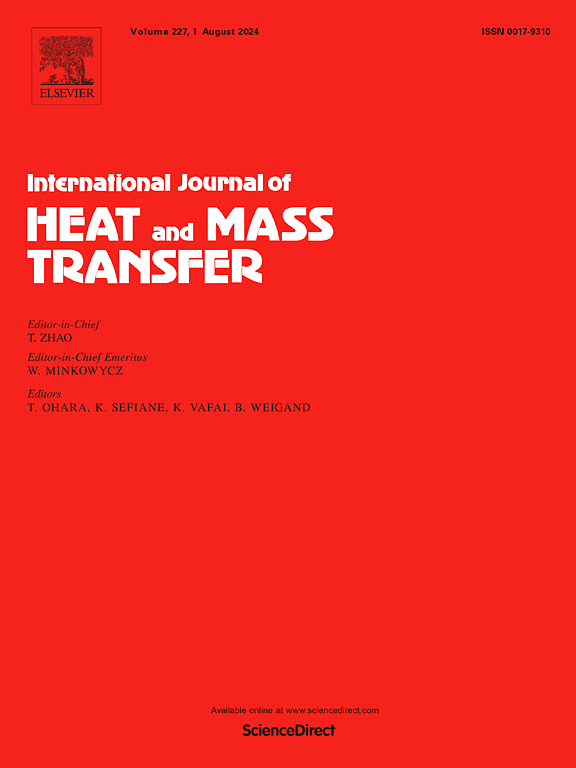A fully coupled multiscale phase-change model at the porous interface for transpiration cooling: coupling dynamics pore-scale networks to continuum-scale free flow
IF 5
2区 工程技术
Q1 ENGINEERING, MECHANICAL
International Journal of Heat and Mass Transfer
Pub Date : 2024-11-07
DOI:10.1016/j.ijheatmasstransfer.2024.126396
引用次数: 0
Abstract
Being a promising method for thermal protection system, transpiration cooling has received wide interest recently. Numerical simulation for transpiration cooling, however, has been limited due to the mis-matching between the pore-scale two-phase flow and external high-temperature aerothermodynamic environment, which induced by conventional decoupled or iterative one-way coupled simplification methods. In this work, a fully coupled continuum-scale and pore-scale model is established for transient transpiration cooling at the interface between boundary layer flow and porous medium through coupling Computational Fluid Dynamics (CFD) and Pore-Network Model (PNM), termed as the multiscale CFD-PNM coupled method. The coupled method allows to capture detailed displacement and phase change of two-phase flow at pore-scale, revealing the strong interaction of the water vapor with the external free flow within a high temperature boundary layer. After successfully validating the new coupled model by comparing with the Two-Phase Mixture Model (TPMM) solution, a number of cases mimicking the cooling at the interface of typical blunt bodies are simulated. The results show that the multiscale CFD-PNM coupled method can not only provide the thermal protection effect prediction, but also reveal many critical features that beyond the reach of continuum-scale studies. Some pore-scale phenomena that are important to the overall transpiration cooling effects are revealed, including transient phase change and composition variation of water vapor, imbibition and drainage of two-phase flow related to pore-scale capillary thresholds and applied boundary pressures, as well as the two-way mass transfer at the interface, such as the invasion of external hot air.
用于蒸腾冷却的多孔界面全耦合多尺度相变模型:孔隙尺度动态网络与连续尺度自由流的耦合
作为一种有前途的热保护系统方法,蒸腾冷却近年来受到广泛关注。然而,由于传统的去耦合或迭代单向耦合简化方法导致孔隙尺度两相流与外部高温空气热力学环境之间的不匹配,蒸腾冷却的数值模拟一直受到限制。在这项工作中,通过耦合计算流体动力学(CFD)和孔隙网络模型(PNM),建立了一个连续尺度和孔隙尺度完全耦合的模型,用于边界层流和多孔介质界面的瞬态蒸腾冷却,称为多尺度 CFD-PNM 耦合方法。这种耦合方法可以捕捉到孔隙尺度上两相流动的详细位移和相变,揭示了高温边界层内水蒸气与外部自由流的强烈相互作用。通过与两相混合物模型(TPMM)的解决方案进行比较,成功验证了新的耦合模型。结果表明,多尺度 CFD-PNM 耦合方法不仅能提供热保护效应预测,还能揭示许多连续尺度研究无法达到的关键特征。这些现象包括水蒸气的瞬态相变和成分变化、与孔隙尺度毛细管阈值和外加边界压力有关的两相流的吸入和排出,以及界面上的双向传质,如外部热空气的侵入。
本文章由计算机程序翻译,如有差异,请以英文原文为准。
求助全文
约1分钟内获得全文
求助全文
来源期刊
CiteScore
10.30
自引率
13.50%
发文量
1319
审稿时长
41 days
期刊介绍:
International Journal of Heat and Mass Transfer is the vehicle for the exchange of basic ideas in heat and mass transfer between research workers and engineers throughout the world. It focuses on both analytical and experimental research, with an emphasis on contributions which increase the basic understanding of transfer processes and their application to engineering problems.
Topics include:
-New methods of measuring and/or correlating transport-property data
-Energy engineering
-Environmental applications of heat and/or mass transfer

 求助内容:
求助内容: 应助结果提醒方式:
应助结果提醒方式:


